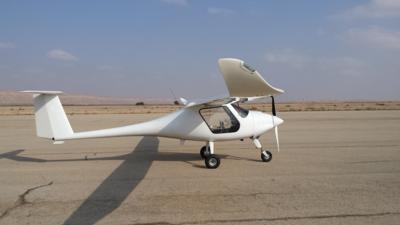UVAOS Conducts Test Flights With Three Converted Pipistrel Sinus Airplanes
A Mountain View, CA-based company specialized in unmanned solutions has created an unmanned aerial complex based on the Sinus light aircraft manufactured Pipistrel. This project is a part of an overall plan to create a multifunctional aerial robotic complex able to carry out group missions with an integrated special payload. Recent test flights demonstrated excellent synchronization of the on-board control system with payload during simultaneous flight of 3 unmanned vehicles.

The aerial complex includes an unmanned aerial vehicle and a ground control station. With a payload weight of 441 lbs, it can fly for 5 hours. The maximum take-off weight of the aircraft is 1410 lbs. The maximum cruising speed is 75 mph, the operating temperature range is -40F to 122F. The flight time with a payload weight of 88 lb is 20 hours. Take-off, en-route flight and landing of the drone are carried out in fully automatic mode.
"Due to the nature of the project, the mission requires a well-coordinated work of the payloads of the aerial robotic complex consisting of 3 UAVs. The customer has opted for an unmanned complex, since installation of such payloads on manned vehicles is dangerous due to the high level of electromagnetic interference that affects the operation of the regular radio navigation equipment. We’ve converted 3 Pipistrel Sinus aircraft into UAVs. We've modified wings of the original aircraft for the installation of hangers for payload, the wiring has been changed, and we've integrated the UAVOS automatic control system," said Vadim Tarasov, UAVOS investor and Board member.
The heavy weight unmanned aircraft are designed for long flight in conditions of high turbulence and overloads – its reinforced fuselage and landing gear are engineered for harsh landing, including grass field aerodromes or prepared sites. The onboard control system is adjustable to almost any payload and provides remote diagnostics, as well as remote control via wireless Internet.
The unmanned aviation complex can be used for surveillance, relay, target indication, towing and dropping targets. An unmanned aircraft will become indispensable during operations in remote regions located far away from the freight transport infrastructure, in agriculture, coastal zone monitoring, or as a research laboratory.
"Why did we decide to utilize serially produced manned aircraft? Because conversion of a manned aircraft into a UAV is the simplest, fastest, most efficient and cost effective method at the initial stage of the creation of specialized heavy UAVs," said Tarasov. "The development and production of a heavy UAV from scratch, including a prototype, testing without a pilot, the preparation of all operating documents, and training of technical personnel requires a huge amount of time and resources. Additionally, there is a major risk to lose a prototype during the tests. At the same time, we had an invaluable opportunity to test the operation of all the units and equipment of the automatic control system, make the ACS settings on board together with the test pilot, especially during automatic take-off and landing."
(Image provided with UVAOS news release)
 ANN's Daily Aero-Linx (05.02.24)
ANN's Daily Aero-Linx (05.02.24) ANN's Daily Aero-Term (05.02.24): Touchdown Zone Lighting
ANN's Daily Aero-Term (05.02.24): Touchdown Zone Lighting Aero-News: Quote of the Day (05.02.24)
Aero-News: Quote of the Day (05.02.24) ANN FAQ: Contributing To Aero-TV
ANN FAQ: Contributing To Aero-TV NTSB Final Report: Cirrus Design Corp SR20
NTSB Final Report: Cirrus Design Corp SR20



